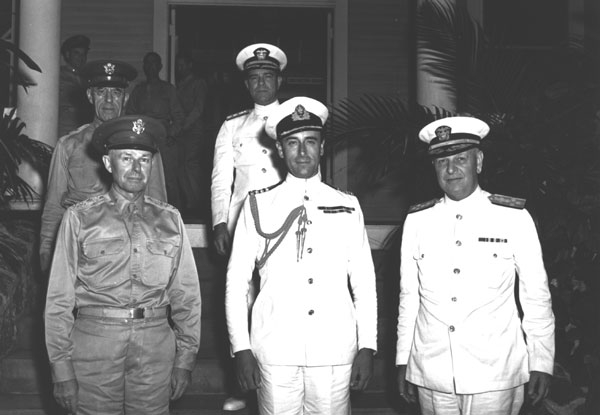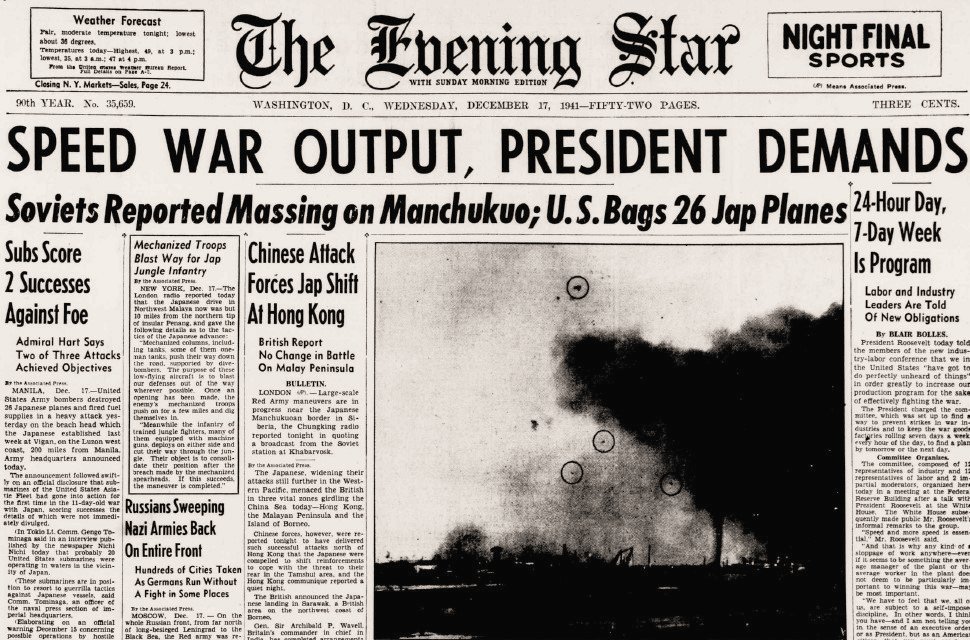World War II Chronicle: December 17, 1941
Click here for TODAY’S NEWSPAPER
Adm. Husband E. Kimmel, serving as Commander in Chief for both the Pacific Fleet (CINCPACFLT) and U.S. Fleet (CINCUS) during the Pearl Harbor attack, has been relieved of command. Taking over temporarily until Rear Adm. Chester W. Nimitz can take over as CINCPACFLT on Dec. 31 is Vice Adm. William S. Pye, who then returns to commanding the Pacific Fleet’s Battle Force (COMBATFOR). Adm. Ernest J. King (currently commanding the Atlantic Fleet) becomes CINCUS on Dec. 30.
Admirals Kimmel and Pye have sons serving in the fleet. Lt. (j.g.) Manning M. Kimmel served on the battleship USS Mississippi before switching to submarines. He now serves on USS Drum, which will soon be prowling, having completed her shakedown on Dec. 7 off the Eastern Seaboard. Ensign John B. Pye serves aboard the cruiser USS Nashville but will soon be headed to sub school at Submarine Base New London, Connecticut. Pye’s other son, Lt. William S. Pye, Jr. perished during a 1938 training flight off the southern California coast while flying carrier-based aircraft for Fighting Squadron 3 (VF-3) off Saratoga.
Lt. Gen. Walter C. Short, Commanding General of the Hawaiian Department, is also getting the axe. Short participated in the Punitive Expedition into Mexico before serving in World War I. He commanded the 1st Infantry Division, then I Corps prior to transferring to Hawaii on Feb. 8, 1941. He is replaced by Lt. Gen. Delos C. Emmons. Maj. Gen. Frederick L. Martin, Commander of the Hawaiian Air Force, is replaced by Brig. Gen. Clarence L. Tinker.
Officers are moved around when a country transitions from peacetime to war, but did any of these commanders fail on Dec. 7? We will have to see how the forthcoming investigations play out, but for now, here’s a quote from former Chairman of the Joint Chiefs, Adm. Thomas H. Moorer: “I have always maintained that had Nelson and Napoleon been in command in Pearl, the results would have been the same.”

Meanwhile, Adm. Frank J. Fletcher’s Task Force 17 departs Pearl Harbor and sails for Wake Island. USS Saratoga is ferrying Marine Fighting Squadron 221 (VMF-221) and their Brewster F2A-3 Buffaloes to reinforce the few surviving planes and pilots of VMF-211 already on the island. Accompanying Saratoga are five destroyers and the heavy cruisers Astoria, Minneapolis, and San Francisco. Fletcher’s task force will rendezvous with the seaplane tender Tangier, oiler Neches, and four destroyers that departed for Wake yesterday.

Documents recovered from wrecked Japanese planes suggest that six carriers attacked Oahu, and intelligence analysts feel that the threat of a follow-up strike has passed — but the Japanese might detach a couple carriers to support the Wake operation as they head home. Regardless, there are six enemy carriers out there and the U.S. Navy can’t risk losing one of theirs so, although hundreds of miles separate the flattops from Fletcher’s force, Lexington (conducting a diversionary raid on the Marshall Islands) and Enterprise (ferrying aircraft to Midway) remain within range to provide cover.
Lexington launches eighteen SB2U-3 Vindicators of Marine Scout Bombing Squadron 231 (VMSB-231) who, accompanied by a PBY Catalina flying escort, conduct the longest mass flight of single-engine aircraft over water on record, flying 1,137 miles to Midway.
With four carriers in the U.S. Atlantic Fleet (Yorktown, Ranger, Wasp, and the recently commissioned Hornet) and the three Pacific carriers stretched thin, Yorktown is reassigned, departing Norfolk, Va. for San Diego on this day…
Pictures of the Japanese attack on Oahu on pages 8-9… Sports section begins on page 44
Evening star. (Washington, D.C.), 17 December 1941. Chronicling America: Historic American Newspapers. Lib. of Congress.
https://chroniclingamerica.loc.gov/lccn/sn83045462/1941-12-17/ed-1/
